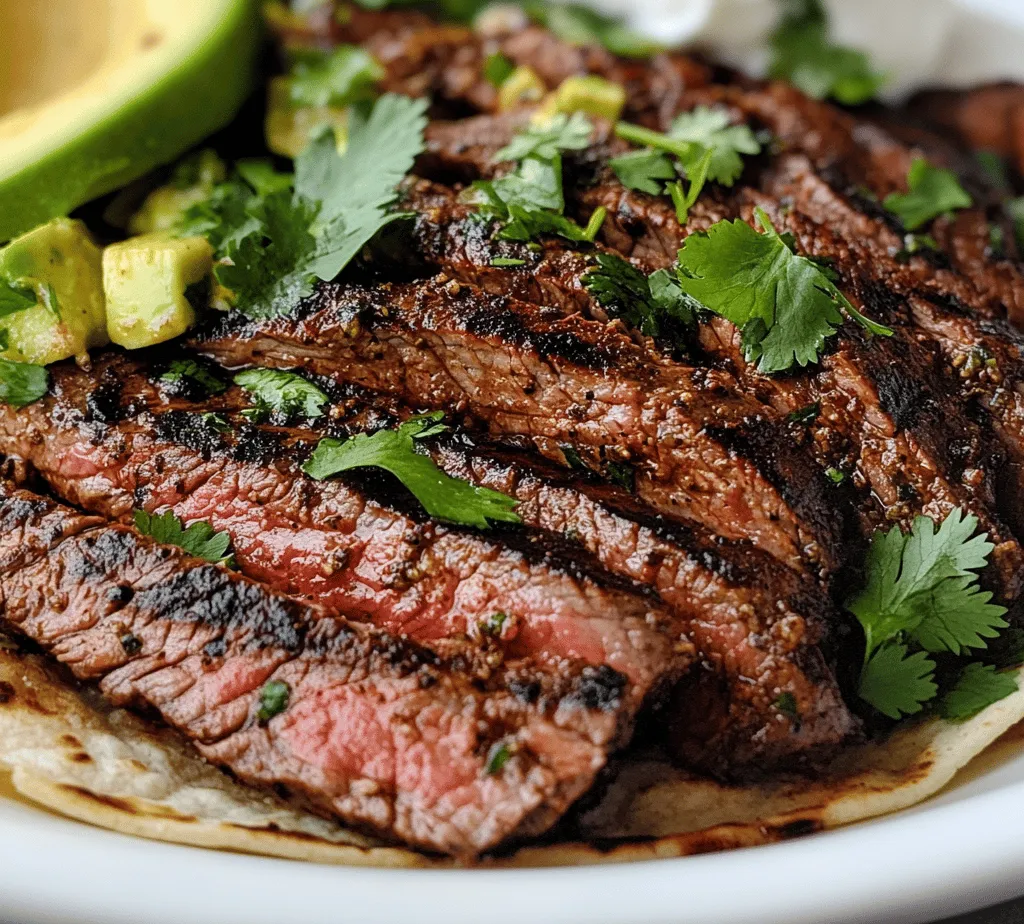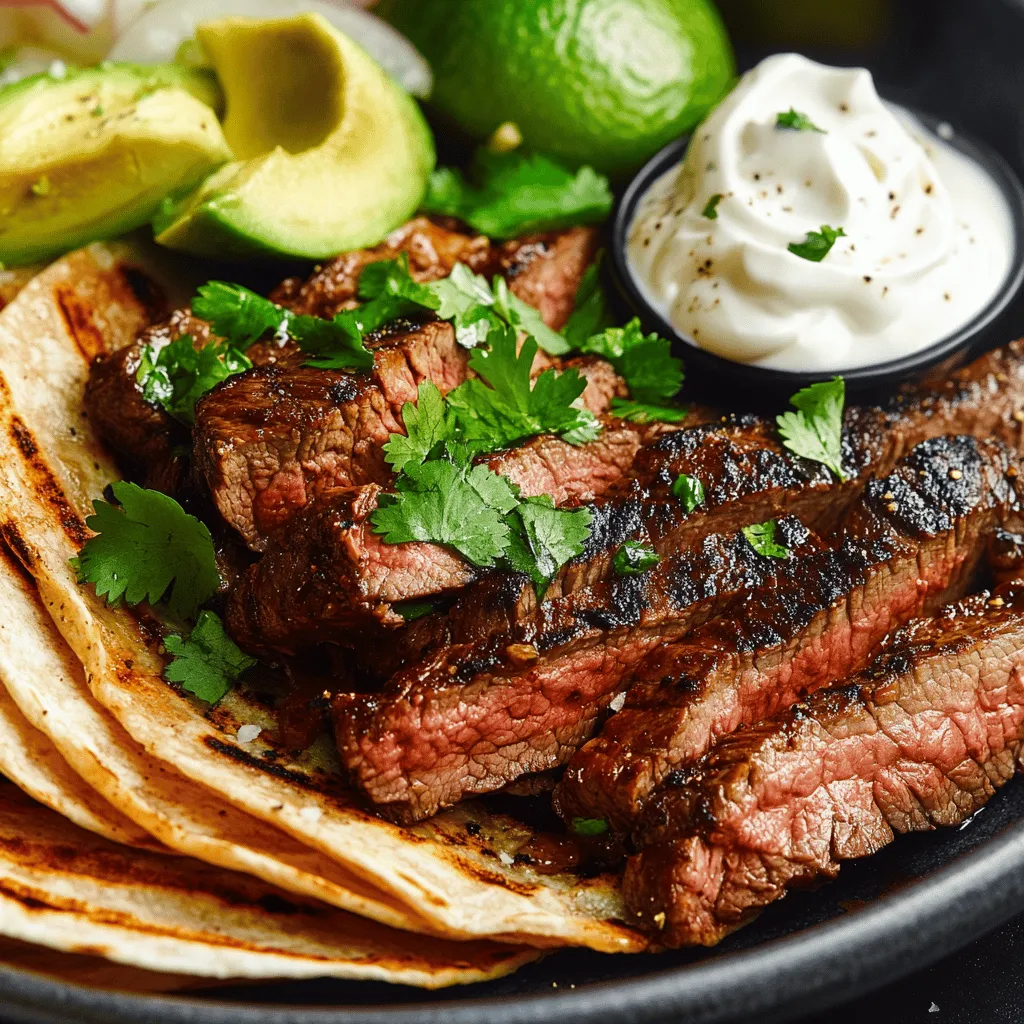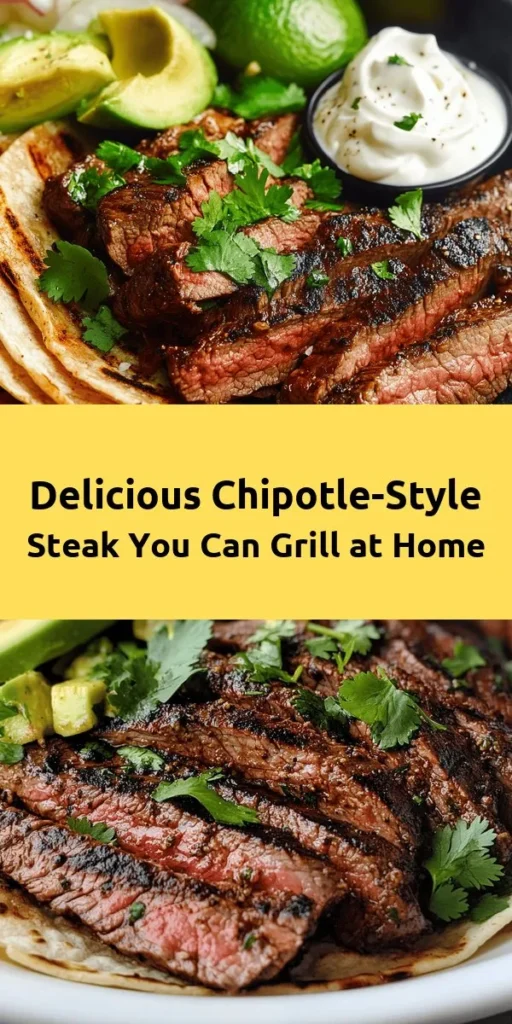Introduction
In the world of culinary delights, few dishes capture the essence of bold flavors and satisfying textures like a perfectly grilled chipotle-style steak. This Sizzling Chipotle-Style Steak recipe not only brings the vibrant taste of Mexican cuisine into your home but also allows you to impress friends and family with minimal effort. From its smoky heat to its tender juiciness, this dish is a true celebration of flavor that can elevate any meal. Whether you’re hosting a barbecue, enjoying a cozy dinner at home, or simply craving something delicious, this recipe has you covered.
The allure of chipotle-style steak lies in its combination of spices, marination, and grilling techniques. With a few simple ingredients and straightforward preparation steps, you can recreate the restaurant-quality experience right in your kitchen. In this article, we will explore the ingredients, preparation steps, and serving suggestions for this mouthwatering dish, ensuring you can recreate it with confidence and flair.
Understanding the Ingredients
Delving into the components of this recipe will enhance your appreciation for its flavors and overall culinary experience. Understanding the ingredients not only equips you with the knowledge to make the dish but also allows you to appreciate the intricacies of each component.
The Key Protein: Flank Steak vs. Skirt Steak
When it comes to selecting the right cut of meat for your chipotle-style steak, both flank steak and skirt steak are popular choices. However, they each have unique characteristics that may influence your decision.
– Flank Steak: This cut comes from the abdominal muscles of the cow and is known for its rich beefy flavor. Flank steak is relatively lean, with long, thin muscle fibers that can be tough if not cooked properly. When grilled correctly, it becomes incredibly tender and flavorful, making it a favorite for steak dishes.
– Skirt Steak: Skirt steak, on the other hand, is cut from the diaphragm muscles of the cow. It has a more pronounced beef flavor and is even more tender than flank steak. The texture of skirt steak is slightly looser, which allows it to absorb marinades exceptionally well. Because of its marbling, skirt steak can also be juicier than flank steak.
When choosing between flank and skirt steak, consider your personal preferences for flavor and texture. Both cuts can yield delicious results, so you can’t go wrong with either option. To ensure the best quality, look for steaks that are bright red in color, with a good amount of marbling throughout. This marbling contributes to the tenderness and flavor of the final dish.
Essential Marinade Components
A great marinade is what truly sets this dish apart, infusing the steak with bold flavors and ensuring it remains tender and juicy. Here’s a breakdown of the essential components that make up our marinade:
– Olive Oil: Olive oil not only adds a rich flavor to the marinade, but it also acts as a tenderizer, helping to break down the meat fibers for a more tender steak. The fat in the olive oil also helps to carry the flavors of the spices and other ingredients.
– Chipotle Peppers in Adobo Sauce: The star of the marinade, chipotle peppers, bring a smoky heat that truly defines this dish. These dried and smoked jalapeños are packed with flavor, and their adobo sauce adds depth and richness. Adjust the amount to suit your heat tolerance; you can use more for a spicier kick or less for a milder flavor.
– Garlic: A classic flavor enhancer, garlic brings an aromatic quality to the marinade. Fresh minced garlic or garlic powder can be used; both will contribute to the overall flavor profile of the steak.
– Ground Cumin and Smoked Paprika: These spices are essential for adding depth to the marinade. Cumin offers a warm, earthy flavor, while smoked paprika adds a subtle smokiness that complements the chipotle peppers beautifully.
– Brown Sugar: To balance the heat from the chipotle peppers, brown sugar is included in the marinade. It provides a touch of sweetness that enhances the overall flavor and promotes caramelization during grilling.
– Salt and Black Pepper: Essential seasonings, salt, and black pepper enhance the natural flavors of the meat. They are crucial for seasoning the steak properly and ensuring that every bite is flavorful.
– Lime Juice: The acidity of lime juice not only adds brightness to the marinade but also helps tenderize the meat. It cuts through the richness of the olive oil and balances the heat from the chipotle, creating a harmonious flavor profile.
Understanding these ingredients and their roles in the marinade will empower you to make adjustments based on your personal preferences. Whether you prefer a spicier or milder flavor, you can easily tweak the quantities to suit your taste.
Step-by-Step Instructions for Sizzling Chipotle-Style Steak
Now that you have a grasp of the key ingredients and their purposes, it’s time to dive into the preparation of this delicious dish. Below is a comprehensive guide to preparing Sizzling Chipotle-Style Steak, with each step elaborated for clarity.
Preparing the Marinade
1. Gather Your Ingredients: Start by assembling all the ingredients for the marinade. You’ll need olive oil, chipotle peppers in adobo sauce, minced garlic, ground cumin, smoked paprika, brown sugar, salt, black pepper, and lime juice.
2. Mix the Marinade: In a medium-sized bowl, combine ¼ cup of olive oil, 2-3 tablespoons of minced chipotle peppers (adjust based on your heat preference), 4 cloves of minced garlic, 1 teaspoon of ground cumin, 1 teaspoon of smoked paprika, 2 tablespoons of brown sugar, 1 teaspoon of salt, ½ teaspoon of black pepper, and the juice of 2 limes. Whisk everything together until fully combined.
3. Taste and Adjust: Before marinating your steak, taste the marinade. This is your opportunity to adjust the flavors. If you prefer more heat, consider adding an extra teaspoon of minced chipotle peppers. For a sweeter profile, add an additional teaspoon of brown sugar. Make sure the balance of flavors suits your palate.
Marinating the Steak
1. Prepare the Steak: If you’re using flank steak or skirt steak, it’s a good idea to trim any excess fat. This will help the marinade penetrate the meat better and prevent flare-ups on the grill.
2. Combine Steak and Marinade: Place the steak in a large resealable plastic bag or a shallow dish. Pour the marinade over the steak, ensuring it’s well-coated on all sides. If using a dish, cover it tightly with plastic wrap.
3. Marination Time: For the best flavor penetration, allow the steak to marinate for at least 1 hour. However, for optimal results, marinating for 4-6 hours or even overnight is recommended. This extended time allows the flavors to meld and the meat to become incredibly tender.
4. Store Properly: If marinating for an extended period, store the steak in the refrigerator. Make sure to keep it in an airtight container or sealed bag to prevent any contamination.
5. Bring to Room Temperature: Before grilling, take the marinated steak out of the refrigerator and allow it to come to room temperature for about 30 minutes. This helps the meat cook more evenly on the grill.
Grilling Techniques for Perfect Doneness
1. Preheat the Grill: Preheat your grill to high heat (about 450°F to 500°F). A hot grill is essential for achieving a nice sear on the steak and locking in the juices.
2. Oil the Grill Grates: To prevent sticking, lightly oil your grill grates with a paper towel soaked in vegetable oil. Use tongs to rub the towel over the grates.
3. Grilling the Steak: Once the grill is hot, remove the steak from the marinade, letting any excess drip off. Place it on the grill, and do not move it for the first few minutes to allow for proper searing.
4. Cook to Desired Doneness: Grill the steak for 4-5 minutes on one side, then flip and cook for an additional 3-5 minutes, depending on your desired doneness. Use a meat thermometer to check the internal temperature:
– Rare: 125°F
– Medium Rare: 135°F
– Medium: 145°F
– Medium Well: 150°F
– Well Done: 160°F
5. Rest the Steak: Once the steak reaches your desired doneness, remove it from the grill and let it rest for 5-10 minutes. This allows the juices to redistribute throughout the meat, ensuring every bite is juicy and flavorful.
By following these steps, you will be well on your way to creating a delicious Sizzling Chipotle-Style Steak that is sure to impress. The combination of bold flavors from the marinade and the perfect grilling technique will result in a dish that is not only satisfying but also a true testament to the vibrant essence of Mexican cuisine. In the next part of this article, we will explore serving suggestions and additional tips for achieving the best results with your steak. Stay tuned!

Preheating the Grill: Why It’s Essential for a Good Sear
Before you start grilling your chipotle-style steak, it is crucial to preheat your grill. This step is vital because a hot grill creates a perfect sear, sealing in the juices and flavors of the meat while developing that desirable crust. Preheating also helps to prevent the steak from sticking to the grill grates, allowing for easy flipping and an ideal texture.
To preheat your grill, set it to high heat (around 450°F to 500°F) and let it heat for about 10 to 15 minutes. You can test whether the grill is hot enough by carefully holding your hand above the grates—if you can only keep it there for 2-3 seconds, the grill is ready. For charcoal grills, ensure that the coals are fully ashed over and spread them evenly for consistent heat.
Recommended Grilling Times Based on Steak Thickness
Grilling times will vary depending on the thickness of your steak and your desired level of doneness. Here’s a handy guide to help you judge your cooking times:
– 1-inch thick steak: Grill for about 4-5 minutes per side for medium-rare (130°F to 135°F).
– 1.5-inch thick steak: Grill for approximately 5-7 minutes per side for medium-rare.
– 2-inch thick steak: Grill for 8-10 minutes per side for medium-rare.
Adjust these times if you prefer your steak cooked to a different doneness level, keeping in mind that thicker cuts will require slightly longer cooking times.
Using a Meat Thermometer for Precision Cooking
To achieve the perfect steak, using a meat thermometer is recommended. This tool will ensure that you cook your steak to the exact temperature you desire. Insert the thermometer into the thickest part of the steak, avoiding any bones. Here are the target temperatures for various levels of doneness:
– Rare: 120°F to 125°F
– Medium-Rare: 130°F to 135°F
– Medium: 140°F to 145°F
– Medium-Well: 150°F to 155°F
– Well Done: 160°F and above
Once your steak reaches the desired temperature, remove it from the grill. Remember that the steak will continue to cook slightly as it rests.
Resting the Steak: Why It Matters
After grilling, it’s essential to let your steak rest. Resting allows the juice to redistribute throughout the meat, enhancing flavor and tenderness. If you cut into the steak immediately after grilling, those precious juices will spill out, leaving you with a dry steak.
To rest your steak, transfer it to a plate and tent it loosely with aluminum foil. Let it rest for at least 5 to 10 minutes. During this time, you can prepare your toppings and sides.
Visual Cues to Determine When the Steak is Ready to Slice
You can tell when the steak is ready to slice by observing its firmness. A properly rested steak will have a slight bounce when gently pressed. Additionally, the color should be vibrant, and the juices should be visible, but not pooling. If you see juices pooling on the plate, it may not have rested long enough.
Slicing and Serving Suggestions
Techniques for Slicing Against the Grain for Tenderness
Slicing your steak correctly is just as crucial as cooking it properly. Always slice against the grain to ensure tenderness. To identify the grain, look for the lines in the meat; these indicate the direction of the muscle fibers. Positioning your knife perpendicular to these lines will give you tender slices that are easier to chew.
Creative Presentation Ideas for Serving with Tortillas and Toppings
For a delightful presentation, serve your sliced chipotle-style steak on a large platter alongside warm tortillas. Arrange toppings like freshly chopped cilantro, diced onions, jalapeños, and lime wedges to give your guests a personalized experience. You can also offer a variety of salsas, such as pico de gallo or tomatillo salsa, for added flavor.
Optional Toppings: Enhancing Flavor and Texture with Fresh Ingredients
To elevate the flavor of your steak, consider adding toppings that add freshness and texture. Some popular options include:
– Avocado slices: Creamy and rich, avocado adds a satisfying contrast to the spicy steak.
– Pickled red onions: Their tangy flavor balances the heat of the chipotle.
– Crumbled queso fresco: This mild cheese adds a delightful creaminess.
– Fresh herbs: Chopped parsley or cilantro brighten up the dish and enhance its presentation.
Pairing Suggestions
Ideal Side Dishes to Complement the Steak
To round out your meal, consider serving your chipotle-style steak with side dishes that enhance its rich and smoky flavors. Here are a few ideas:
– Fresh Salads: A simple salad with mixed greens, cherry tomatoes, and a lime vinaigrette can provide a refreshing contrast to the robust steak.
– Popular Mexican Sides: Rice and beans are classic accompaniments. You can prepare cilantro lime rice and refried black beans for a complete meal.
– Grilled Vegetables: Bell peppers, zucchini, and corn can be grilled alongside your steak for added nutrition and flavor.
Beverage Pairings
Choosing the right beverage can elevate your dining experience even further. Here are some recommendations:
– Wines: A robust red wine like a Malbec or a Cabernet Sauvignon can complement the rich flavors of the steak beautifully.
– Beers: A dark lager or a hoppy IPA will enhance the smoky notes of the chipotle marinade.
– Non-Alcoholic Drinks: For a refreshing option, try serving aguas frescas, like hibiscus or lime, which balance the heat of the dish.
Cultural Significance of Chipotle-Style Steak
Historical Context of Chipotle in Mexican Cuisine
The chipotle pepper, a smoked and dried jalapeño, has deep roots in Mexican cuisine. Historically, the process of smoking peppers dates back centuries, allowing them to be preserved and providing a unique flavor profile. Chipotle peppers are often used in salsas, marinades, and sauces, making them a staple ingredient in Mexican cooking.
The combination of chipotle with grilled meats exemplifies the region’s culinary traditions, where fire and smoke play a significant role in flavor development. Each region of Mexico may have its unique takes on chipotle-style dishes, influenced by local ingredients and cooking methods.
Influence of Regional Cooking Styles on Modern Recipes
Modern interpretations of chipotle-style steak often blend traditional techniques with contemporary influences, making it a beloved dish around the world. The versatility of chipotle peppers means they can be adjusted to suit various tastes, whether you’re in a bustling Mexican market or a suburban backyard.
Conclusion
Savoring sizzling chipotle-style steak at home opens the door to a world of rich flavors and cultural experiences. This dish not only satisfies the taste buds but also invites a sense of community and celebration around the dinner table. By following the outlined steps and understanding the significance of each ingredient, you can master this recipe and bring a taste of authentic Mexican cuisine into your kitchen. Enjoy the process of cooking and the delicious rewards that follow!



